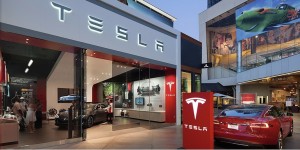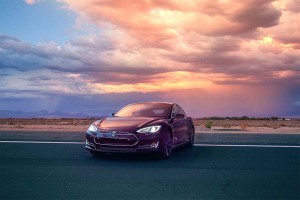Battery-carmaker Tesla Motors is set to make the biggest bet in its short life Thursday night with the official unveiling of the all-new Model 3.
At an estimated price of $35,000, the new sedan will cost less than half as much as the base version of the current Tesla Model S and, if all goes according to plan, transform the California carmaker into a serious mainstream, rather than niche, manufacturer.
According to some observers, Tesla could very quickly log more than 100,000 early reservations. But not everyone is convinced, one analyst warning that “fundamental headwinds” could prove more substantial than Tesla’s ever-upbeat founder and CEO Elon Musk has anticipated.
Among other things, Tesla won’t be the first to enter the battery-car market with an affordable, long-range option. That honor will go to General Motors which unveiled its 200-mile Chevrolet Bolt at the Consumer Electronics Show in January. That five-door model will reach Chevy’s vast showroom network months ahead of the Model 3.
(Click Here for a close look at the Chevrolet Bolt.)
The launch of the Model 3 is a potential game-changer for Tesla. The Silicon Valley carmaker has developed an intensely loyal cadre of fans for its two existing models, the original Model S sedan and the newer Model X battery SUV launched late last year. But sales numbers have been modest, Tesla delivering barely 50,000 vehicles last year, slightly less than it originally forecast.
Both vehicles can deliver nearly 300 miles per charge, as much as triple the range of almost all current competing battery-electric vehicles, or BEVs. But the price is significant: the Model S starts at around $70,000, the Model X $10,000 more – and running to $132,000. That’s a key reason why Credit Suisse analyst Dan Galves said in a research note that among those who test drive a Model S, “only about 15% actually buy the car,” compared to 50% for the average vehicle.
At a starting price of $35,000, the Model 3 would be only slightly higher than the $33,781 average transaction price American motorists paid for a new vehicle in February 2016, according to data compiled by Kelley Blue Book.
While Tesla won’t reveal specific details about the new Model 3 until 8:30 PM Pacific Time on Thursday, some details have begun leaking out. The base Model 3 is expected to deliver less range than the Model S, something closer to the Chevy Bolt’s 200 miles per charge. In keeping with current practice, Tesla may offer longer-range versions at a higher price. And it also is likely to offer higher performance options, along the lines of the Model S with so-called Ludicrous Mode.
A key factor allowing Tesla to deliver even 200 miles at that price is the sharp decline in the cost of lithium-ion battery technology. According to Mark Reuss, the global product development chief at GM, the maker will spend about $145 per kilowatt-hour for the basic battery cells in the Bolt. At 60 kWh, that comes in at around $8,700 – or about $50,000 less than what the same batteries would have cost at the beginning of the decade.
Tesla could get its batteries for even less, some observers have suggested, once it completes the new Gigafactory battery plant it is setting up in Reno, Nevada.
Cheaper batteries alone won’t ensure the success of the Model 3, some analysts warn. UBS analyst Colin Langan warns of “fundamental headwinds,” including Tesla’s precarious balance sheet. Even using its own, liberal accounting methods it has struggled to get into the black in recent years due to the unexpectedly hefty cost of product development.
Credit Suisse analyst Galves is more upbeat, anticipating Tesla will quickly take orders from almost all of the existing 107,000 Model S and Model X owners, as well as those who would love a Tesla if it were more affordable.
But David Sullivan, senior analyst with AutoPacific, Inc., stresses that the Model 3 can’t just be seen as a more affordable version of the Model S. With Tesla hoping to boost its sales to 500,000 vehicles a year by around the end of the decade, it will have to target a very different type of buyer.
“With a mainstream car you’re going to have more mainstream service, better parts availability, better body repairs,” Sullivan says, adding that, “They’re going to have to fix their quality issues and their service issues. Mainstream buyers won’t look past those problems” like the current fan-boy owner base.
Tesla has received numerous kudos for the basic design and features of its two luxury-class models. Influential Consumer Reports magazine, for example, said the Model S “broke” its test scale last year with the highest score it ever recorded. But just a few months later, CR revoked its “Recommended Buy” rating for the battery sedan, citing an array of quality and reliability issues.
Where the Chevy Bolt will be available for both sales and service at more than 1,000 U.S. dealerships, Tesla’s showroom count is measured by the dozens. The maker has been locked out of a number of states, such as Michigan, because of its insistence on using only factory-owned, rather than franchised, dealerships. And it does not work with independent repair or body shops, even for vehicles out of warranty.
While Tesla will begin taking orders for the Model 3 this week, it says it won’t actually launch production until late next year, and Morgan Stanley analyst Adam Jonas says 2018 is more likely considering the Model X was over two years late to market.
(Better late than never. Click Here for more on the Model X.)
For its part, a recent blog post on the Tesla website suggested, “We recognize that everyone wants to get their Model 3 as quickly as possible. Our overarching goal is to maximize total customer happiness within the bounds of what is physically possible.”
As to the decision to name the new battery-car the Model 3, that might seem to reflect its role as Tesla’s third production model. In fact, it is a bit of a joke on the part of CEO Musk. The original plan was to call it the Model E, but that name was registered by Ford Motor Co. So instead, he explains, Tesla will now have a line-up that still spells out S-3-X.
(For more on Tesla’s sales, Click Here.)



